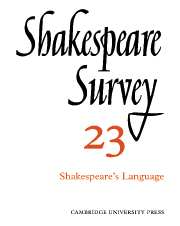Book contents
- Frontmatter
- Shakespeare and the Tune of the Time
- Some Functions of Shakespearian Word-formation
- Guide-lines for Interpreting the Uses of the Suffix ‘-ed’ in Shakespeare’s English
- Shakespeare’s Use of Colloquial Language
- Words, Action, and Artistic Economy
- ‘Antony and Cleopatra’: the Limits of Mythology
- Shakespeare’s ‘War with Time’: the Sonnets and ‘Richard II’
- Shakespeare and Christian Doctrine: Some Qualifications
- Shakespeare’s Poets
- The Text of Coleridge’s 1811–12 Shakespeare Lectures
- Shakespeare Studies in German: 1959–68
- A Neglected Jones/Webb Theatre Project: ‘Barber-Surgeons’ Hall Writ Large
- Interpretation or Experience? Shakespeare at Stratford
- 1 Critical Studies
- 2 Shakespeare’s Life, Times, and Stage
- 3 Textual Studies
- Index
- Plate section
3 - Textual Studies
Published online by Cambridge University Press: 28 March 2007
- Frontmatter
- Shakespeare and the Tune of the Time
- Some Functions of Shakespearian Word-formation
- Guide-lines for Interpreting the Uses of the Suffix ‘-ed’ in Shakespeare’s English
- Shakespeare’s Use of Colloquial Language
- Words, Action, and Artistic Economy
- ‘Antony and Cleopatra’: the Limits of Mythology
- Shakespeare’s ‘War with Time’: the Sonnets and ‘Richard II’
- Shakespeare and Christian Doctrine: Some Qualifications
- Shakespeare’s Poets
- The Text of Coleridge’s 1811–12 Shakespeare Lectures
- Shakespeare Studies in German: 1959–68
- A Neglected Jones/Webb Theatre Project: ‘Barber-Surgeons’ Hall Writ Large
- Interpretation or Experience? Shakespeare at Stratford
- 1 Critical Studies
- 2 Shakespeare’s Life, Times, and Stage
- 3 Textual Studies
- Index
- Plate section
Summary
The need for a new Shakespeare concordance, more complete and more accurate than John Bartlett’s New and Complete Concordance of 1894, may not have been acute but it existed and it was inevitable that the aid of computers would be enlisted in compiling such a concordance. Not one but two computer-generated concordances are now in course of publication. The first volumes of Marvin Spevack’s modern-spelling concordance, based on the forthcoming Riverside Shakespeare under the textual editorship of G. Blakemore Evans, were reviewed last year. The year 1969 has seen the publication of five sections of T. H. Howard-Hill’s old-spelling concordance, based on the text of the First Folio and of selected Quartos. His Oxford Shakespeare Concordances are intimately related to Dr Alice Walker’s Oxford Shakespeare and use the early text of each play which she has chosen as her copy-text. Fears that the two concordances may render each other redundant are to some extent mitigated by the two editors’ widely differing aims and methods: Spevack’s promises to be a useful work of general reference, Howard-Hill’s is essentially a tool for minute study of Shakespeare’s language and text which preserves the linguistic and typographical details of the early texts.
- Type
- Chapter
- Information
- Shakespeare Survey , pp. 176 - 186Publisher: Cambridge University PressPrint publication year: 1970

